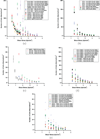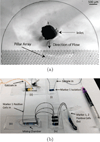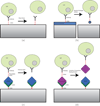Generation of tissue constructs for cardiovascular regenerative medicine: from cell procurement to scaffold design
- PMID: 22951918
- PMCID: PMC3527695
- DOI: 10.1016/j.biotechadv.2012.08.006
Generation of tissue constructs for cardiovascular regenerative medicine: from cell procurement to scaffold design
Abstract
The ability of the human body to naturally recover from coronary heart disease is limited because cardiac cells are terminally differentiated, have low proliferation rates, and low turn-over rates. Cardiovascular tissue engineering offers the potential for production of cardiac tissue ex vivo, but is currently limited by several challenges: (i) Tissue engineering constructs require pure populations of seed cells, (ii) Fabrication of 3-D geometrical structures with features of the same length scales that exist in native tissue is non-trivial, and (iii) Cells require stimulation from the appropriate biological, electrical and mechanical factors. In this review, we summarize the current state of microfluidic techniques for enrichment of subpopulations of cells required for cardiovascular tissue engineering, which offer unique advantages over traditional plating and FACS/MACS-based enrichment. We then summarize modern techniques for producing tissue engineering scaffolds that mimic native cardiac tissue.
Copyright © 2012 Elsevier Inc. All rights reserved.
Figures







Similar articles
-
Engineering Functional Cardiac Tissues for Regenerative Medicine Applications.Curr Cardiol Rep. 2019 Aug 1;21(9):105. doi: 10.1007/s11886-019-1178-9. Curr Cardiol Rep. 2019. PMID: 31367922 Free PMC article.
-
Regenerative therapy and tissue engineering for the treatment of end-stage cardiac failure: new developments and challenges.Biomatter. 2012 Jan-Mar;2(1):1-14. doi: 10.4161/biom.19429. Biomatter. 2012. PMID: 23507781 Free PMC article. Review.
-
Fabrication of Cardiac Constructs Using Bio-3D Printer.Methods Mol Biol. 2021;2320:53-63. doi: 10.1007/978-1-0716-1484-6_6. Methods Mol Biol. 2021. PMID: 34302647
-
Biomaterial based cardiac tissue engineering and its applications.Biomed Mater. 2015 May 20;10(3):034004. doi: 10.1088/1748-6041/10/3/034004. Biomed Mater. 2015. PMID: 25989939 Free PMC article. Review.
-
Biophysical stimulation for in vitro engineering of functional cardiac tissues.Clin Sci (Lond). 2017 Jul 1;131(13):1393-1404. doi: 10.1042/CS20170055. Clin Sci (Lond). 2017. PMID: 28645929 Review.
Cited by
-
Cyto- and bio-compatibility assessment of plasma-treated polyvinylidene fluoride scaffolds for cardiac tissue engineering.Front Bioeng Biotechnol. 2022 Nov 4;10:1008436. doi: 10.3389/fbioe.2022.1008436. eCollection 2022. Front Bioeng Biotechnol. 2022. PMID: 36406217 Free PMC article.
-
Perspective on microfluidic cell separation: a solved problem?Anal Chem. 2014 Dec 2;86(23):11481-8. doi: 10.1021/ac5013283. Epub 2014 Nov 10. Anal Chem. 2014. PMID: 25350696 Free PMC article. Review.
-
PGS:Gelatin nanofibrous scaffolds with tunable mechanical and structural properties for engineering cardiac tissues.Biomaterials. 2013 Sep;34(27):6355-66. doi: 10.1016/j.biomaterials.2013.04.045. Epub 2013 Jun 6. Biomaterials. 2013. PMID: 23747008 Free PMC article.
-
New Three-Dimensional Poly(decanediol-co-tricarballylate) Elastomeric Fibrous Mesh Fabricated by Photoreactive Electrospinning for Cardiac Tissue Engineering Applications.Polymers (Basel). 2018 Apr 19;10(4):455. doi: 10.3390/polym10040455. Polymers (Basel). 2018. PMID: 30966490 Free PMC article.
-
Evaluating the biological risk of functionalized multiwalled carbon nanotubes and functionalized oxygen-doped multiwalled carbon nanotubes as possible toxic, carcinogenic, and embryotoxic agents.Int J Nanomedicine. 2017 Oct 19;12:7695-7707. doi: 10.2147/IJN.S144777. eCollection 2017. Int J Nanomedicine. 2017. PMID: 29089764 Free PMC article.
References
-
- Beltrami AP, Barlucchi L, Torella D, Baker M, Limana F, Chimenti S, Kasahara H, Rota M, Musso E, Urbanek K, Leri A, Kajstura J, Nadal-Ginard B, Anversa P. Adult cardiac stem cells are multipotent and support myocardial regeneration. Cell. 2003;114(6):763–776. - PubMed
Publication types
MeSH terms
Grants and funding
LinkOut - more resources
Full Text Sources
Other Literature Sources
Miscellaneous

